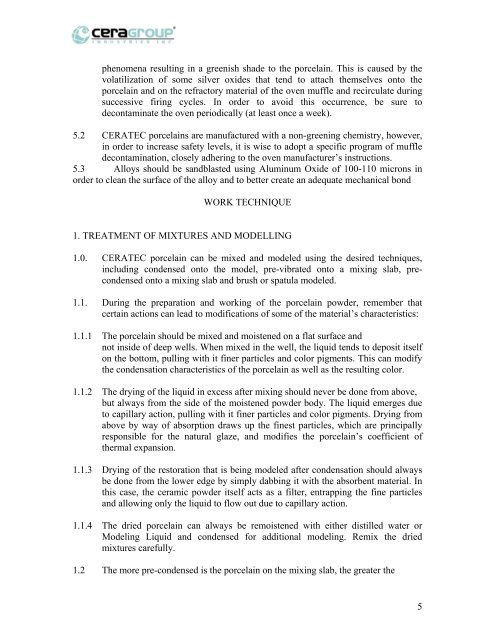CERATEC PORCELAIN
CERATEC PORCELAIN
CERATEC PORCELAIN
Create successful ePaper yourself
Turn your PDF publications into a flip-book with our unique Google optimized e-Paper software.
phenomena resulting in a greenish shade to the porcelain. This is caused by the<br />
volatilization of some silver oxides that tend to attach themselves onto the<br />
porcelain and on the refractory material of the oven muffle and recirculate during<br />
successive firing cycles. In order to avoid this occurrence, be sure to<br />
decontaminate the oven periodically (at least once a week).<br />
5.2 <strong>CERATEC</strong> porcelains are manufactured with a non-greening chemistry, however,<br />
in order to increase safety levels, it is wise to adopt a specific program of muffle<br />
decontamination, closely adhering to the oven manufacturer’s instructions.<br />
5.3 Alloys should be sandblasted using Aluminum Oxide of 100-110 microns in<br />
order to clean the surface of the alloy and to better create an adequate mechanical bond<br />
WORK TECHNIQUE<br />
1. TREATMENT OF MIXTURES AND MODELLING<br />
1.0. <strong>CERATEC</strong> porcelain can be mixed and modeled using the desired techniques,<br />
including condensed onto the model, pre-vibrated onto a mixing slab, precondensed<br />
onto a mixing slab and brush or spatula modeled.<br />
1.1. During the preparation and working of the porcelain powder, remember that<br />
certain actions can lead to modifications of some of the material’s characteristics:<br />
1.1.1 The porcelain should be mixed and moistened on a flat surface and<br />
not inside of deep wells. When mixed in the well, the liquid tends to deposit itself<br />
on the bottom, pulling with it finer particles and color pigments. This can modify<br />
the condensation characteristics of the porcelain as well as the resulting color.<br />
1.1.2 The drying of the liquid in excess after mixing should never be done from above,<br />
but always from the side of the moistened powder body. The liquid emerges due<br />
to capillary action, pulling with it finer particles and color pigments. Drying from<br />
above by way of absorption draws up the finest particles, which are principally<br />
responsible for the natural glaze, and modifies the porcelain’s coefficient of<br />
thermal expansion.<br />
1.1.3 Drying of the restoration that is being modeled after condensation should always<br />
be done from the lower edge by simply dabbing it with the absorbent material. In<br />
this case, the ceramic powder itself acts as a filter, entrapping the fine particles<br />
and allowing only the liquid to flow out due to capillary action.<br />
1.1.4 The dried porcelain can always be remoistened with either distilled water or<br />
Modeling Liquid and condensed for additional modeling. Remix the dried<br />
mixtures carefully.<br />
1.2 The more pre-condensed is the porcelain on the mixing slab, the greater the<br />
5





